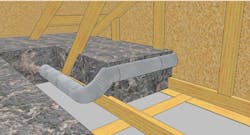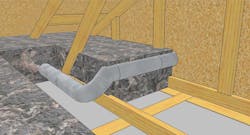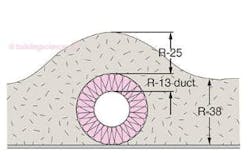How Deep is Deep Enough to Bury Ducts?
Turns out, ducts buried under insulation actually can work to save energy and eliminate condensation inside the ducts. If you seal and insulate them first
As home performance becomes more important—because of codes and consumers—the HVAC system is taking a more central role.
A key aspect of forced air heating and cooling systems is moving air from one place to another. This involves ducts and insulation. Because it costs money to heat and cool air, it is preferable for the air to arrive at the end of the duct very near the same temperature that it was when it entered the duct, back at the air handler unit. Worse than just comfort issues, poorly insulated ducts can cause condensation inside the ductwork, which can lead to all sorts of moisture, mold, IAQ, and comfort problems.
One way to keep the temperature stable is to keep the ducts inside the conditioned space—on the inside side of the insulation. You can do this with dropped soffits or by moving the attic insulation to the underside of the roof deck.
That stuff is a PIA, and it is expensive.
The easiest—and least expensive—way to do it is to put the ducts in the attic and bury them with insulation.
At least, that's what Dr. Joe says in a recent article on BuildingScience.com called No Sweat, referring to the critical R-value balance that eliminates condensation problems. Burying ductwork in insulation had been somewhat looked down upon by the BS crowd because no one really knew how much to insulate the ducts. And because ducts usually leak.
Thanks to a lot of research and testing by CARB and Home Innovation Labs, the elusive magic R-values are now known:
- For climate zones 1A, 2A, and 3A—where the ceiling insulation requirement is R-38— you can insulate ductwork to R-13, you can cover it with R-25 (about 7 inches of cellulose) to get to R-38.
Images from building science.com
- For climate zones 4 and higher—where the ceiling Insulation requirement is R-49—insulate the ducts to R-8 and cover them with an additional R-41 (about 12 inches of cellulose) to get to R-49.
- You can also go the R-8 ducts and additional R-30 loose-fill over the top in the lower climate zones (1-3).
The catch, Joe says, is that the ducts must be airtight (starting to sound familiar?), allowing 5 percent leakage or less at 25 Pascals of pressure.
Duct mastic is always a good idea, but closed-cell spray foam, at R-6.5 per inch, can do double duty.
"High-density spray polyurethane foam works when we spray it over R-6 and R-8 ducts in hot humid and mixed humid climates at a little more than 1-inch thick. But low-density foam does not work."
The last word on buried ducts? Probably not.
More to Explore:
- Building Science Corporation: No Sweat
- ProTradeCraft: 18 Ways to Get Better Performance From Flexible Ducts
- US Department of Energy: Compact Buried Ducts in a Hot-Humid Climate House
- ProTradeCraft: Three Dryer Venting Tips



